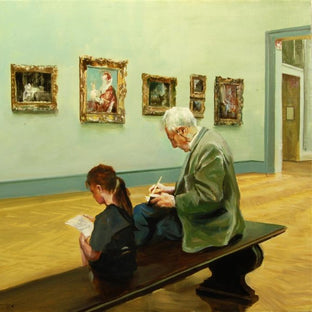When our friends and clients ask us whether they should be somewhat vigilant about common insects causing damage to their collections, the answer is yes. Nonetheless, we don't necessarily recommend going so far as to acquire a specially-trained Weimaraner to do a periodic sweep of your home for artwork-eating bugs. Fortunately for us all, there are less complicated options for protecting an art collection from these vermin. As part of our series on caring for your paintings and art, we’re taking a closer look at this pesky problem.
Art-Eaters and Painting-Parasites: What You Should Know
There are some common culprits when it comes to insects and pests that like to feast on paper, textiles, and other fine art. Frequent offenders in the insect species include carpet beetles, clothes moths, worms, booklice, termites, flies, and silverfish. In addition to winged warriors and creepy crawlers, rodents such as mice are also capable of creating chaos for your collection. Evidence of their antics includes holes in your artwork or stains which result from droppings.
By way of examples, clothes moths have been known to wreak havoc on treasured historic textiles in European museums. Not only do these critters consume precious fabrics, but they lay tiny eggs that hatch larvae deep within the fibers. Paper works are particularly vulnerable to silverfish which love dark, damp environments and enjoy nibbling on paper products, such as your valuable watercolor works. Silverfish are found throughout the United States and are often undetected until they’ve already started to cause problems.
You know what they say about an ounce of prevention being worth a pound of cure. While it’s good to know the signs, you don't want to wait to take action until there are obvious indicators of insect damage because at that point the harm is already done, which will necessitate intervention and remediation by an art restoration professional. Before it gets to that point, follow a few simple guidelines for protecting your art from insects and pest infestations.
1. Keep Your Domicile Reasonably Clean
Nothing makes a pest sadder than a well-cleaned and cared-for space. We recently spoke with a friend in the pest control business who shared that the homes which require the least attention are those which are kept reasonably clean. This is especially true for those spaces where we either display or store our art and paintings.
With this in mind, regularly dust your art and the furniture that occupies space nearby. You don’t have to spend endless hours scrubbing and mopping each day, but maintaining a generally good housekeeping routine is a helpful practice for keeping insects and other pests away.
2. Food and Art Don't Mix
Speaking of cleanliness, most museums and fine art galleries prohibit the storage of art and paintings in office spaces because their employees are known to snack or take meal breaks in their workspaces. An associate of ours recently shared how ants took over her office for this very reason.
Food remnants we may unintentionally leave behind are like laying out the welcome mat to bugs and mice. Those crumbs can represent a trail of danger when it comes to your art collection, so while it may be tempting to snack in various living spaces within your home, limiting food to the kitchen and dining areas is highly advisable.
3. Frame Your Artwork
Framed artwork has obvious advantages when it comes to keeping insects at bay. While it won't necessarily create an impenetrable barrier for insect attacks, frames establish an additional hurdle for predatory bugs to overcome.
As it relates to deterring pests, art experts recommend framing your art with mitered corners and ensuring your preferred framer incorporates a sealed backing to your works. As always, selecting the right professional framer who is well-versed in original works and utilizes archival methods is critical for ensuring the best protection from insects and other potential hazards.
4. Consider Pest Control
If you notice a bug issue developing in your home that could impact your personally owned art, you can try traps as a first step to mitigate the problem, though taking more aggressive measures to prevent pests from accessing your beloved paintings and textiles is sometimes necessary. While there may be apprehension about the use of insecticides, some museums and art galleries employ the tactic of hiring a professional pest control service as a last resort. As to whether these products can damage art, it’s a complicated question. The Smithsonian advises the following:
Whether a museum object will be harmed is more difficult to determine. In discussing and describing infested objects with a professional pest control operator (PCO) or entomologist, use material class terms (leather, wool, softwood) and be careful to mention all composite materials (protein glue, brass fittings, silver threads).
5. Don't Create Cozy Spaces for Crawly Critters
Bugs such as the aforementioned silverfish are big fans of humidity. With this in mind, if it is necessary to store your art pieces, make sure to do so in an environment that is uninviting to insects and other creatures. If possible, create a somewhat dry environment in your storage spaces and maintain cool temperatures. Additionally, to prevent easy access, stored paintings shouldn't be placed directly on the floor.
We hope these simple tips help you navigate the best ways to prevent infiltration and damage by insects and other pests. As with all things art preservation-related, when in doubt, consult a professional.
If you're in the market to add to your collection of original art, you can peruse the latest works by talented artists on our website, which is refreshed and updated with new art weekly.







